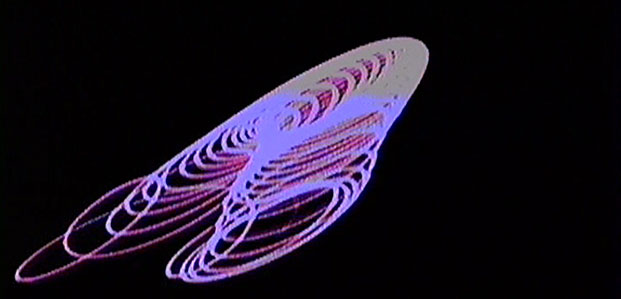'OPTICAL
SENSATION - video noise and abstract cinema'
Film- und videoprogramme curated by Florian Wüst

April
28, 2007,9 p.m.
Beatles Electronique, Nam June Paik & Jud Yalkut,
USA, 1966-69, 3'
EMS nr 1, Ralph Lundsten, SE, 1966, 14'
neon, Timo Novotny & Nik Thoenen, A, 2002, 4'
Noisefields, Steina & Woody Vasulka, USA, 1974, 12'
Printer Light Play, Arthur & Corinne Cantrill, AUS, 1978, 6'
Lights, Marie Menken, USA, 1965, 6'
collider 2, Didi Bruckmayr, A, 2005, 4'30''
April
29, 2007, 9 p.m.
Violin Power, Steina Vasulka, USA, 1970-78, 10'
Partitür, Jean-François Guiton, BRD, 1983, 9'
Blue Mercury, Matthew Schlanger, USA, 1987, 4'
YAGA! Take a call please..., Józef Robakowski, PL, 1993, 4'30''
ILOX, Karø Goldt, A, 2000, 3'
Composition 6, Marc Burkett, NL, 1987, 12'
Synchronator, Bas van Coolwijk & Gert-Jan Prins, NL, 2006, 6'
The two-part programme "optical sensation - video noise and abstract cinema" presents artistic films and videos from 1965 - 2006 which explore the materiality of cinematic media and the formal relationship of sound and image. In the course of this, spacial transfigurations, light patterns, visual rhythms and electronic scores, exceeding the representation of objective reality, are created in a fascinating manner. With the help of analog and digital manipulations, the works reach an outstanding musical quality. Seeing and listening becomes an audio-visual experience outside common viewing practices and often pushes beyond the boundaries of physical perception.
The history of experimental film has always been marked with the need to dissociate from the conventions of narrative cinema. Through the montage of images that transgress the photographic depiction of the world, that transform it into greatest possible abstraction or even leave behind the camera-made picture by ways of animating geometrical or amorphous forms and surfaces or through the manual treatment of the film strip, it was made possible to capture what is intrinsic to film: light and motion.
With the advent of video art in the 1970s, these approaches to experimenting with images in motion were applied to video. The use of formal systems for editing sequences, the development of self-generating graphical patterns or the principle of serial repetition resulted in the dissolution of the logical relationship of time and space which seemed so embedded in the real time transmitability of video and televison. Furthermore, the alteration of the electronic signal by mechanical devices, musical instruments or the body helped to generate synthetic sounds and images that established the distinctive vocabulary of the new technology. For some time now, the digital possiblities of the computer allow an increasing differentiation in the production of abstract cinematic images.
"optical sensation - video noise and abstract cinema" combines historical and contemporary 16mm films and videos, from, amonst others, Marie Menken, Ralph Lundsten or the Vasulkas via Jean-François Guiton and Józef Robakowski up to the latest work of Bas van Coolwijk & Gert-Jan Prins. By bridging five decades, the programmes intend to make visible the ambivalent relationship of poetics and abstraction, logic and transcendence. At the interface of experimental film, video art and electronic music, this relationship is reciprocal, constantly shifting, and last but not least often refering back to its own history.
(Florian Wüst)